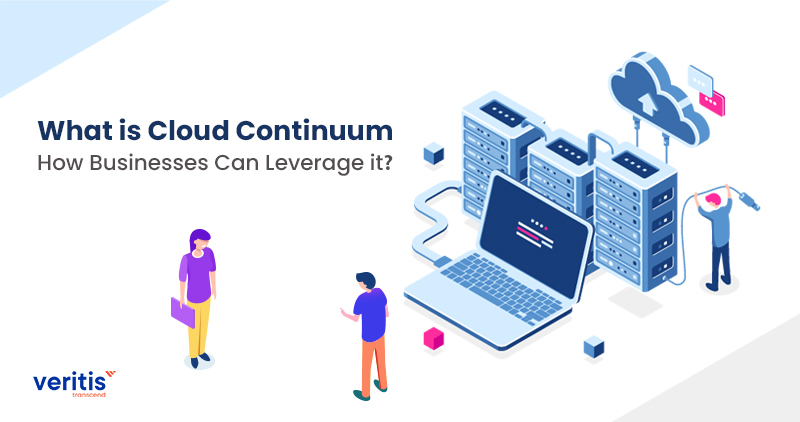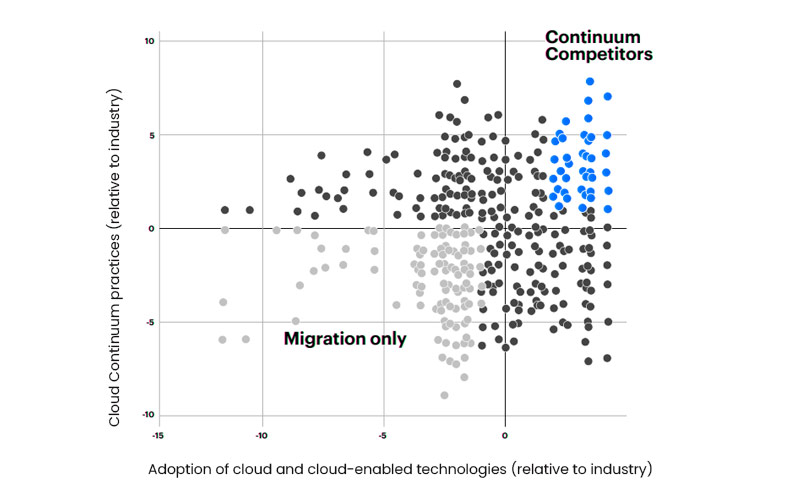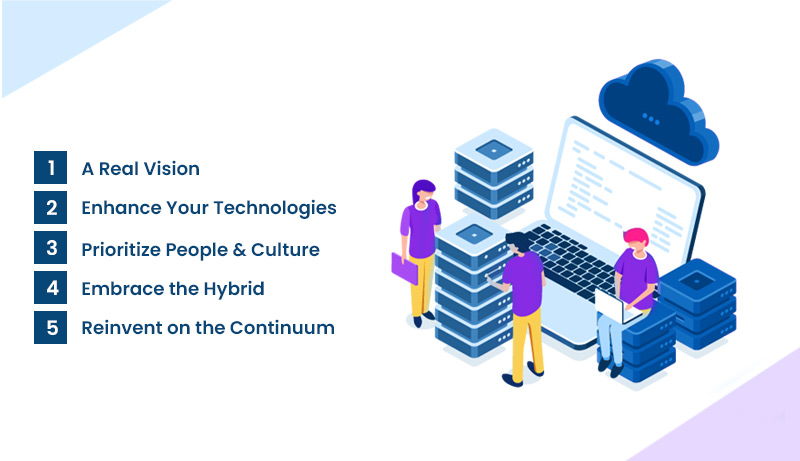
Table of contents
Change is constant. Many organizations are reimagining their business models by migrating to the cloud. Some migrate to innovate and re-engineer knowledge work, while others want to save costs and boost efficiency.
Regardless of their objectives, every organization is migrating as business needs change. The juice is worth the squeeze—many are realizing impressive results from cloud migration strategies.
As of January 2024, approximately 5.54 billion individuals worldwide are utilizing the Internet, constituting 70.4% of the global population. Projections suggest that this figure will continue to rise steadily over the year. (Source: Worldometer)
The global cloud market is projected to achieve a valuation of USD 623.3 billion by the year 2024, experiencing a notable growth rate of 23.1%. This expansion is primarily fueled by heightened demand for remote work solutions, data storage services, and cloud-based applications across various industries. (Source: Statista)
Although the cloud has been in the limelight for decades, the pandemic has significantly boosted cloud adoption strategy. The cloud managed services aren’t just about on-demand computing power and storage, as they were during the pre-pandemic period.
Instead, it’s an innovative platform for discovering opportunities and options for meeting the business’s ever-changing needs. Moreover, the cloud is no longer a single, static, siloed technology. Instead, the cloud Continuum’s a dynamic continuum of capabilities and features.
Talk To Our Cloud Computing Consultant
What is Cloud Continuum and How Businesses Can Leverage It?
The cloud continuum represents the evolving ecosystem of cloud solutions that seamlessly integrate private cloud, public cloud, hybrid cloud, edge computing, and emerging AI-driven services. Unlike traditional siloed environments, the continuum enables enterprises to orchestrate workloads, data, and operations across multiple environments, providing maximum agility, performance, and cost efficiency.
Businesses today are no longer limited to a single cloud strategy. By embracing the cloud continuum, organizations can optimize innovation velocity, operational scalability, and competitive differentiation in a fast-changing digital landscape.
Introducing the Cloud Continuum Control Plane
Modern enterprises require more than just cloud infrastructure; they need a unified framework to manage, monitor, and optimize operations across the continuum. The Continuum Control Plane, with its efficient management, monitoring, and optimization capabilities, is the solution.
Key Highlights of the Continuum Control Plane:
1) Unified Governance & Visibility: A single layer to manage cloud, edge, and hybrid environments.
2) Operational Lenses:
- FinOps: Cost transparency and optimization
- AIOps: AI-driven monitoring and automation
- SecOps: Unified security and compliance
- DevOps/GitOps: Faster deployments and streamlined workflows
- BizOps: Aligning IT operations with business KPIs
3) Incremental Maturity: The Continuum Control Plane is designed to adapt and evolve, helping organizations transition from siloed cloud adoption to full-stack orchestration and innovation platforms.
5 Stages of Cloud Continuum

The “Cloud Continuum” refers to the evolutionary stages of cloud adoption and maturity within organizations. Here’s a breakdown of the five stages:
1) Ad Hoc Cloud Usage
At the initial stage, organizations typically use the cloud ad hoc. This involves sporadic and uncoordinated utilization of cloud implementation resources, often driven by individual departments or teams. A lack of centralized governance and strategy results in inefficiencies and potential security risks.
2) Cloud Awareness and Experimentation
In this stage, organizations become more aware of the benefits of cloud computing and start experimenting with cloud managed services. They may pilot projects or migrate non-critical workloads to the cloud to test their capabilities. However, the cloud adoption strategy remains limited, and there’s a focus on learning and building internal expertise.
3) Cloud Integration and Optimization
As organizations progress, they integrate cloud service providers more strategically into their IT infrastructure. There’s a shift towards optimizing workloads for the cloud environment, leveraging automation, scalability, and cost-efficiency. This stage involves rearchitecting applications for cloud-native environments and adopting DevOps practices for faster delivery.
4) Cloud-centric Operations
At this stage, the cloud implementation becomes the primary platform for running business operations. Organizations fully embrace cloud-native technologies and practices, such as microservices, serverless computing, and containerization. They prioritize agility, innovation, and scalability, leveraging advanced cloud services like AI/ML, IoT, and Big Data analytics.
5) Cloud-driven Transformation
In the final stage, the cloud adoption strategy drives fundamental organizational transformations. Cloud technology has become ingrained in the company culture and business strategy, enabling new business models, revenue streams, and customer experiences. Organizations achieve unprecedented agility, resilience, and competitive advantage through cloud-centric approaches.
Each stage of the Cloud Continuum represents a progression towards greater cloud maturity, with organizations evolving from initial experimentation to fully realizing cloud computing’s transformative potential for driving innovation and growth.
Useful Link: AWS Vs Azure Vs GCP – The Cloud Platform of Your Choice?
How Cloud Continuum Benefits Businesses?
A recent global survey by Accenture of about 4,000 business and IT leaders found that 12-15% of respondents benefit from their continued cloud engagement. These businesses are gaining an edge despite the global crisis as they embrace the cloud as an innovative platform for discovering new operating methods.
Organizations working in this Cloud Continuum are termed Continuum Competitors as they leverage the cloud not just as a siloed, distributed destination but as a seamless operating model. The continued cloud engagement transforms how businesses engage with customers, employees, and partners, develop and deliver their products and services, and operate their IT systems. In a nutshell, the Cloud Continuum is reimagining the way businesses operate.
Cloud Continuum empowers organizations to gain an edge over their competitors. Some substantial benefits are:
- 2-2.7x more cost reduction than typical cloud migrators
- 2-3x more likely to innovate and re-engineer operating models
- 3x more likely to realize sustainability goals through cloud
Cloud Continuum also enables organizations to choose the appropriate types of cloud technologies and services and harness the full potential of those technologies. This technology foundation strengthens organizations to reimagine and reinvent their business through continuous innovation.
However, Cloud Continuum success is more effortless than done. While Continuum holds massive potential to bolster businesses, making it work for you is tough.
Cloud Continuum empowers organizations to gain an edge over their competitors. Some substantial benefits are:

- 2-2.7x more cost reduction than typical cloud migrators
- 2-3x more likely to innovate and re-engineer operating models
- 3x more likely to realize sustainability goals through cloud

Useful Link: 10 Cloud Computing Trends Which Shall Dominate 2025
What are the Impediments for Cloud Continuum Adoption?
Key challenges that are bogging down companies from rapidly expanding cloud adoption and leveraging the Continuum are:
- 42% Changing business and operating models
- 42% Security and compliance risks
- 35% IT and business gaps
- 34% Complex legacy systems
- 32% Data concerns and regulations
How can organizations overcome these obstacles to derive maximum business value from the Cloud Continuum? Read on to learn the leading practices for Cloud Continuum success.
5 Key Practices to Unlock the Potential of Cloud Continuum
However, before you start, the first step is understanding the nature of the Cloud Continuum: speed and change are its fundamental facets. Continuum practices that can harness the continual improvements and expansion of cloud implementation capabilities are crucial. This is where cloud consulting services prove invaluable, helping organizations stay adaptive and aligned with evolving cloud technologies.
Firstly, one must understand the nature of the Cloud Continuum before getting started. Speed and change are its USPs. Moreover, one must know that it’s imperative to have agile practices that can leverage continual developments and expansion of cloud data platform capabilities. With that in mind, here are five crucial practices to achieve Continuum success:

1) A Real Vision
To start the Cloud Continuum adoption journey, organizations must know where they want the voyage to take them. Given the continually expanding nature of Continuum, it’s imperative to hammer out clear priorities that will act as guardrails for the organization to move in the desired direction.
A right Continuum strategy encompasses the following aspects:
- A vision that clearly defines the core objectives
- Competitive vulnerabilities and shortcomings
- Present capabilities of the organizations and future aspirations
2) Enhance Your Technologies
Cloud migration strategy is not a destination. It’s an ongoing journey. Migrating and sitting back to enjoy the ride will take you nowhere. After the migration, organizations must work on extra steps such as using Edge to develop on the cloud data platform, leveraging PaaS services to realize new capabilities, or adopting AI/ML to glean insights from your data and processes.
Otherwise, you fail to realize the full potential of the cloud that your competitors enjoy. Organizations ought to establish cloud practices that bolster their existing technologies. This aspect enables you to improve your non-technological areas and keep them on par with the computational amendments.
3) Prioritize People and Culture
Continuum competitors consider people and culture when implementing cloud transformation. They use the cloud data platform to improve customer experience, employee productivity, organizational agility, and innovation. To achieve this, one must align, invest, and adopt.
Organizations ought to align C-suite executives, shareholders, and partners to promote a combined understanding of the value and potential of Continuum adoption. Then, one must invest in improving cloud skills and digital fluency across the organization. The last puzzle is adopting new operating models to improve working methods, eliminate bottlenecks, and increase innovation.
4) Embrace the Hybrid
The Cloud Continuum offers limitless opportunities. However, organizations can adopt hybrid cloud solutions from multiple platforms to optimally suit their business needs. To do so, they must shift from siloed cloud models to integrated platform strategies that embrace multiple clouds and new technologies.
5) Reinvent on the Continuum
Migrating critical systems and data to the cloud is the crucial step of a successful cloud journey, but it’s just the start. No matter where you are on the cloud, continuous improvement is possible.
Companies must ask themselves how to leverage cloud and cloud-based technologies like AI/ML, edge, 5G, and PaaS to position their businesses for sustained growth in the years ahead. They must be ready to exploit every opportunity that comes their way with the Cloud Continuum.
Emerging Trends: Edge, AI, and Hybrid-First Strategies
The future of cloud is intelligent, distributed, and hybrid. Organizations adopting the Edge-Cloud Continuum are unlocking new possibilities:
1) Edge Computing for Real-Time Needs
- Healthcare: Real-time patient monitoring & diagnostics
- Manufacturing: Edge analytics for production quality & efficiency
- Smart Cities: Traffic management, energy optimization, and public safety
2) AI and Automation Integration
- Embedding AIOps for proactive monitoring and predictive scaling
- Using machine learning at the edge to reduce latency and enhance decision-making
3) Hybrid-First Architecture Decisions
- Workload placement based on latency, compliance, and performance trade-offs
- Leverage 5G, SDN, and orchestration tools to bridge on-premises and cloud
Roadmap to Cloud Continuum Adoption
To maximize value, businesses should follow a structured maturity roadmap:
1) Assessment: Identify current cloud adoption and gaps
2) Continuum Control Plane Setup: Build unified visibility and governance
3) Adopt Continuum Competitor Practices: Align with business priorities and KPIs
4) Expand to Edge & AI: Extend capabilities to latency-sensitive workloads
5) Optimize & Innovate: Continuously refine for cost, speed, and innovation
Case Study: Navigating the Cloud Continuum for a Financial Services Client
Veritis partnered with a leading finance and insurance company to transform its IT infrastructure through full-fledged automation and hybrid cloud adoption. This strategic shift enabled the client to transition along the cloud continuum from legacy systems to a flexible, integrated environment that combines on-premises, private, and public cloud resources. Veritis automated provisioning, optimized workload distribution, and ensured secure data handling, empowering the client with a future-proof solution that can adapt continuously to evolving business and compliance needs.
This case exemplifies how organizations can leverage the cloud continuum to unlock agility, control, and significant cost efficiency over time, providing a clear financial benefit.
Read the complete case study: Full-Fledged Infrastructure Automation & Cloud Support to Finance and Insurance Company.
Conclusion
Though Cloud Continuum holds massive potential to bolster business, organizations must balance their Continuum objectives with strategic priorities that drive the business. Organizations must define business objectives, establish feasible levels of risk-taking, and promote a culture of agility and innovation. This is easier said than done.
As Cloud Continuum is still unchartered territory, it’s practical to say that complexities and challenges are lurking at every corner, which could potentially bog down the organization’s Continuum initiatives. This is why one must seek help from Cloud Managed Services Providers like Veritis, who are well-versed in navigating the cloud challenges.
Veritis brings deep domain knowledge and industry expertise to chart a course for every organization looking to advance on the Cloud Continuum. As a leading Cloud Services Provider, we help you unlock your business’s full potential in the cloud. Partner with us and tap into future potential.
Ready to assess your Cloud Continuum readiness?